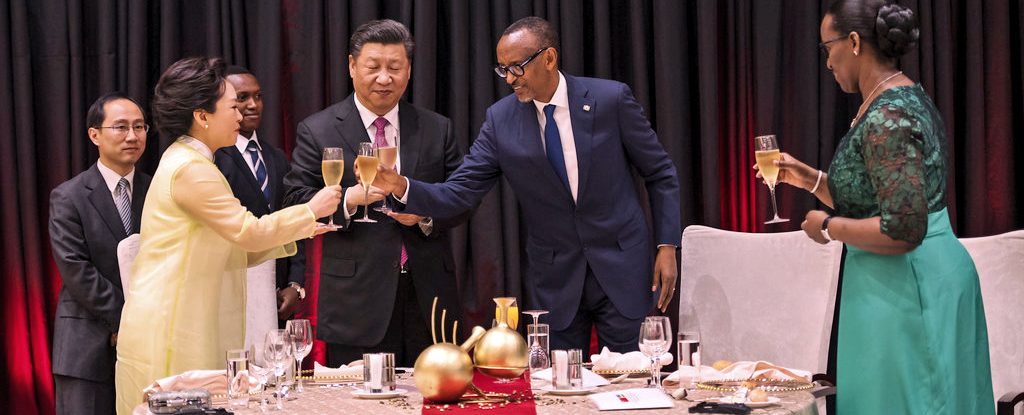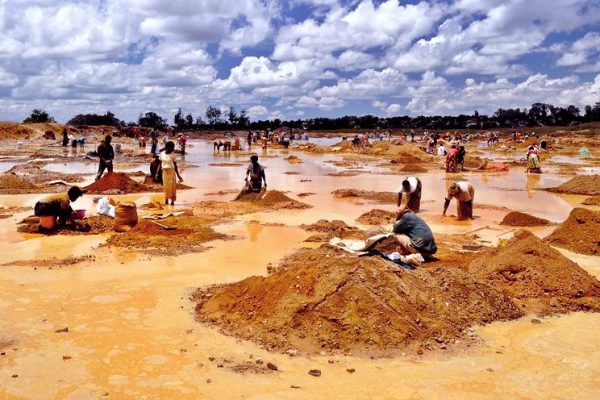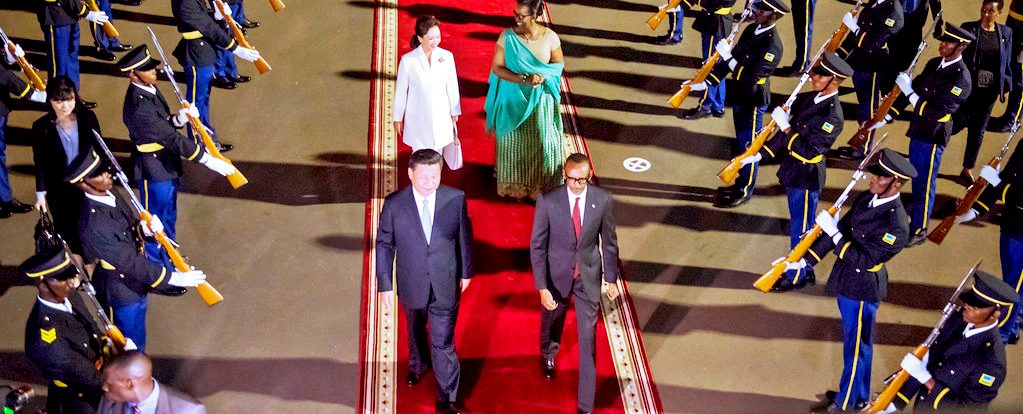
Rwandan President Paul Kagame hosting Chinese President Xi Jinping. (Photo: Office of the President of Rwanda)
Guānxì (关系) is a defining feature of how China cultivates its diplomatic partnerships. Guānxì is a system of beliefs in Chinese culture that shapes how reciprocity is built through personal ties and mutual obligations. An individual who benefits from another’s guānxì is obliged to return the favor to enable the relationship to continue and to ensure one’s goals are secure. This is called “win-win solutions” (liǎng quán qí měi; 两全其美) where both sides “get the best of both worlds.”
In political and business settings, guānxì ties can be heavily instrumentalized, emphasizing material gain, interests, power, and influence. Many Chinese political scientists note that the Communist Party of China is held together by complex factional ties based on proximity to top leaders, length of service, and familial, historical, or regional backgrounds. The strength of one’s informal social network is often more consequential than formal titles or positions.
Many African political settings thrive on similar dynamics and patron-client linkages. Institutions, laws, and regulations often play a secondary role in such situations.
“The net effect of guānxì is that African elites reap financial rewards and entrench their patronage networks while Chinese firms benefit by increasing their political clout.”
While guānxì should theoretically give African countries leverage in their Chinese engagements, African leaders tend to use this reciprocity to obligate their Chinese partners to invest in leaders’ personal projects. A study of the geography of Chinese foreign assistance in Africa found that Chinese-funded projects in 49 countries between 2000 and 2012 were substantially more likely to be allocated to the birth regions of African presidents.
The net effect of instrumentalized guānxì is that African elites reap financial rewards and entrench their patronage networks while Chinese firms benefit by increasing their political clout, which they use to further their interests. In short, it is a “win-win” arrangement—for the individuals involved.
The Africanized Guānxì Context
The $3.6 billion Mombasa-Nairobi-Naivasha “Madaraka Express,” Kenya’s most expensive project since independence, is a case in point of how African leaders have been adept at leveraging guānxì for their own benefit. The Madaraka Express was the brainchild of a Kenyan entrepreneur, Jimmy Wanjigi, who had strong ties to China and senior Kenyan officials. He introduced the China Roads and Bridges Corporation (CRBC) to the Kenyan government in 2008 to work out a deal.
It was a classic case of guānxì. Kenyan officials viewed the idea as a legacy project that could enhance their re-election bids. CRBC, on the other hand, welcomed the opportunity to build political connections with Kenyan leaders and generate influence through CRBC’s ability to access debt financing from China. It was a “win-win” for all involved. However, the project was mired in corruption scandals from the start due to the highly personalized nature of how it was negotiated and remains unfinished. The Kenyan Court of Appeal ruled in June 2020 that the contract between the government and CRBC was “illegal” as it flouted Kenya’s procurement laws.

Nairobi Terminus building of the “Madaraka Express.” (Photo: Macabe5387)
A different set of dynamics were at play during negotiations over the Democratic Republic of the Congo’s (DRC’s) massive $9 billion resources-for-infrastructure deal in 2007. This controversial project (dubbed “Congo’s Marshall Plan”) was conceived in 2006 by close advisors of former President Joseph Kabila, key business allies, and top executives of the state-controlled mining giant, La Générale des Carrières et des Mines (Gécamines).
The DRC sits on top of the world’s largest cobalt reserves and some of the largest reserves of copper. Although the country was already saddled with $13 billion in debt (for which it was seeking relief under the IMF’s Heavily Indebted Poor Countries (HIPC) Initiative), Kabila’s lieutenants made a bold play. They persuaded China Railway Group Limited (the world’s largest construction company in terms of revenue), Sinohydro (China’s largest energy giant), and Zhejiang Huayou Cobalt to form a mega consortium with Gécamines called Sino Congolaise des Mines (Sicomines). In exchange for mining titles, the Chinese partners would deliver infrastructure and social services: roads, hospitals, schools, hydroelectric dams, and clinics.

Workers washing ore at a Gécamines mining site. (Photo: Fairphone)
The Export–Import Bank of China (China Exim Bank) extended $9 billion in credit, which Sicomines would pay back with profits from the mining venture. The Chinese partners would receive 10.6 million tons of copper and 627,000 tons of cobalt from Gécamines in a barter exchange.
Kabila’s handpicked cadres were in charge at Gécamines, the Bureau de Coordination et de Suivi du Programme Sino-Congolais (BCPSC), the Agence Congolaise des Grands Travaux (ACGT), and the infrastructure ministry. They constituted a powerful guānxì base as they had access to Kabila and were privy to sovereign decisions. This made them vitally important to the Chinese side. The Chinese partners’ guānxì was built on their access to loan finance that the Congolese needed badly. Each side delivered for the other in a “win-win” fashion.
The highly personalized nature of these exchanges heightened the risks on all sides, however. Parliament claimed it was not involved nor even informed of the project. The deal was criticized for violating the DRC’s Mining Code, which forbids the presidency from offering special tax arrangements. Western partners, who were engaged in HIPC talks with Kabila at the time, vigorously opposed the venture. However, Kabila refused to cancel it. Instead, he persuaded the Chinese side to modify the clauses that unsettled his Western partners, and the loan was reduced to $6 billion. These concessions worked. Kabila kept the Sicomines deal and received HIPC relief to the tune of $11 billion.
“The instrumentalized notions of guānxì exchanges reinforce the highly informal nature of Africa-China negotiations that mostly occur behind the scenes and among elites.”
While arguably a demonstration of skilled negotiations on Kabila’s part, the deal remained highly unstable as it depended more on personal ties and assurances, political brokerage, and the exchange of favors rather than rules and regulations. Insecurity, fluctuations in commodity prices, lack of available infrastructure, and the DRC’s highly fractious political environment dogged it at every turn. In 2012, the China Exim Bank withdrew from the deal, but returned after the Chinese partners approached other policy banks. As an indication of their heightened perception of risk, however, Chinese firms have not negotiated new infrastructure for resource swaps in the DRC ever since. In 2020, DRC President Felix Tshisekedi issued a ban on all mining pending an investigation into deals struck by his predecessor, including Sicomines.
The instrumentalized notions of guānxì exchanges reinforce the highly informal nature of Africa-China negotiations that mostly occur behind the scenes and among elites. Between 2000 and 2021, African countries concluded 1,141 financing instruments with various Chinese policy and commercial banks, state-owned enterprises, diplomats, and business elites. Public oversight of such instruments and disclosure of the terms of these arrangements have been the exception rather than the norm.
Recognizing this, on the margins of the 8th Ministerial Conference of the Forum on China-Africa Cooperation (FOCAC) in Dakar in November 2021, leading African experts on Africa-China relations called for the establishment of an independent observatory of African civil society to ensure that the relationship is more beneficial for Africa. Thanks to pressure and engagement by civil society, all six of the 10-year frameworks of the AU’s Agenda 2063 have been incorporated into the 80-plus projects that were outlined in the Dakar China Africa Plan 2022-2024. Parallel to these efforts, negotiators from 15 West African countries have formed a platform to share experiences in negotiating with Chinese stakeholders, identify problems, and institutionalize best practices. Liberia, Benin, and Sierra Leone offer examples of West African countries that have negotiated commitments from their Chinese partners to include technological and skills transfer in all their projects.
A Moral Debt?
Affinity, solidarity, and “intimate friendship” or “comrades-in-arms” (qīnmì zhàn yǒu; 亲密战友) have long been part of China’s diplomatic style in Africa. In reflecting on the decisive African vote that tipped the scales in favor of recognizing the People’s Republic of China’s seat at the United Nations in 1971, Salim Ahmed Salim, the then Organization of African Unity Secretary General, noted that “The chemistry [between Africans and Chinese] was very good; they stood with us and we felt morally obliged to reciprocate.” He was referring to China’s longstanding support for African liberation movements dating back to the late 1950s, that earned China significant political capital and diplomatic goodwill. In Dakar, Xi Jinping vowed that China “will never forget” Africa’s role in restoring it to the UN, a claim all his predecessors had repeated whenever they received African delegations.

Opening ceremony of the 2018 FOCAC summit.
(Photo: Présidence de la République du Bénin)
China also cultivates qīnmì zhàn yǒu by deliberately aligning its goals closely with African wishes. For example, in 2019, it agreed to align its Belt and Road Initiative with the African Union’s (AU’s) Program for Infrastructure Development in Africa. This was reaffirmed in the FOCAC Dakar Action Plan (2022-2024) and the China-Africa Cooperation Vision 2035. One in five infrastructure projects in Africa is constructed by Chinese firms and one in three is funded by Chinese policy banks to the tune of roughly $11 billion annually. This generates significant political capital for China. More generally, African leaders share a strong view that China consistently responds quickly and decisively to their needs. This may explain why more African leaders attend FOCAC summits than any other meeting, including the United Nations General Assembly, the world’s largest summit.
Chinese leaders also undertook 82 visits to 40 African countries between 2009 and 2018 when the 7th FOCAC summit was held. Over the same period, African leaders visited China 222 times. With all this networking and exchanges, it is unsurprising that China can consistently count on African backing in international fora. In July 2020, for example, 25 African states were part of a block of 53 countries that backed China’s new Hong Kong national security law against 27 mainly Western states. In October, no AU member signed a German letter condemning Chinese policies in Xinjiang, putting African diplomats in direct conflict with a U.S.-German coalition of 39 countries. And between 2015 and 2018, China received near unanimous African votes in 56 formal interventions at the UN Human Rights Council, including resolutions that inserted Chinese political concepts such as the “aspiration to build a community of shared future for human beings,” into UN texts for the first time.
“Absent oversight, guānxì-styled relations have been used by African leaders to advance their personal interests.”
Another example of China’s ability to cultivate sentiments of reciprocity can be seen in the steps it took to neutralize potential resistance to its plan to open its first overseas military base in Djibouti in 2017. Less than a year earlier, the AU Peace and Security Council issued a stern resolution noting “with deep concern the existence of foreign military bases and establishment of new ones in some African countries.” It warned member states to be “circumspect” about such agreements. A series of targeted Chinese investments in the preceding years helped overcome these misgivings. Between 2008 and 2016, China’s People’s Liberation Army (PLA) conducted 294 interactions in 40 African countries. Some 259 of these were working visits held alternately in Africa and China to build rapport with defense leaders. Twenty-two were naval port calls and 13 were military exercises—highlighting the focus on relationship-building.
In 2012, China handed over the brand new $200 million AU headquarters—funded and built entirely by Chinese firms—as a “gift to the African people.” In 2015, China tripled its financial pledges to $60 billion, up from $20 billion in 2012. Then in 2016, China launched a $100 million Africa Peace and Security Fund to operationalize the African Standby Force. By 2017, it was all but certain that African leaders would not refuse China’s request to station a base on African soil.
The Ties that Bind: Guānxì from the Ground Up
FOCAC builds and replenishes the political capital to sustain ties of solidarity, familiarity, reciprocity, and influence. The 2021 Dakar summit saw China’s pledges for training, networking, and capacity-building continue their upward trajectory. A 40-page document elaborates a large portfolio of planned multisector engagements that will push upwards the 100,000-training quota offered at the last FOCAC summit in 2018. This quota represents a 100 percent increase from the 50,000 pledged in 2015. China’s longstanding focus on cultivating, harvesting, and replenishing ties of familiarity and political capital was reaffirmed.
The people-to-people networking and relationship-building occur outside the media spotlight through a “cascading model” that forms part of the FOCAC structure. It trains more African professionals, students, civil servants, and soldiers than any other country. The nine strategic pillars of China-Africa relations are organized into high level subforums, such as the China-Africa Defense Forum, that assemble senior leaders on both sides once or twice a year to set the tone and define priorities. These feed into lower level subforums that are smaller in size, more frequent, and targeted, such as the China-Africa Press Center that offers 10-month fellowships to journalists annually. At the national level, institutions like the Confucius Institutes (74 in 40 African countries as of 2019) and numerous semiofficial bodies, like the China-Africa Friendship Association, provide venues for deeper networking and relationship-building. They extend into academia, the private sector, and industry.

Presidents Paul Kagame and Xi Jinping. (Photo: Office of the President of Rwanda)
China is also active on the political front. The Communist Party of China (CPC) trains over 2,000 African cadres annually, many of whom are paired with their Chinese counterparts for hands-on mentorship. Through the Forum on China Africa Local Government Cooperation, an arm of the CPC, over 10,000 local government leaders train each year at China’s political schools. At China’s elite Executive Leadership Academy in Pudong, African trainees can study alongside rising leaders earmarked for senior positions in the CPC. Many beneficiaries of such exchanges return home to continue the China-Africa partnership, a tangible outcome of China’s networking model. For example, Uganda’s Luyanzi College—one of the largest institutes for Chinese education in Africa—was started by Ugandan nationals educated and trained in China.
Conclusion
China’s approach to partnership relations emphasizing reciprocity theoretically creates opportunities for African countries to exert leverage during Africa-China negotiations. In practice, absent oversight and political ethics, guānxì-styled relations have been used by African leaders to advance their personal interests. The arrangements are mutually beneficial—but for the individuals involved not the publics they represent. As African citizen agency becomes more established, and more independent platforms are created to inform policy debates in Africa, the ability to oversee the informal guānxì networks will be vital for strengthening standards of accountability on the continent.
Additional Resources
- Development Reimagined, “From China-Africa to Africa-China: A Blueprint for a Green and Inclusive Continent-Wide Africa Strategy Towards China,” Special Report, June 2021.
- Philani Mthembu and Faith Mabera (eds.), Africa-China Cooperation: Towards an African Policy on China? (London: Palgrave Macmillan, 2020).
- Lina Benabdallah, Shaping the Future of Power: Knowledge Production and Network-Building in China-Africa Relations (Ann Arbor: University of Michigan Press, 2020).
- Paul Nantulya, “Strategic Application of the Tao 道 of Soft Power: The Key to Understanding China’s Expanding Influence in Africa,” The African Review Vol. 47, No. 2, October 2020.
- Neil Thomas, “Ties That Bind: Xi’s People on the Politburo,” Marco Polo, June 17, 2020.
- Yun Sun, “Chinese Campaigns for Political Influence in Africa,” Stimson Center, May 8, 2020.
- Zhang Lihua, “China’s Traditional Cultural Values and National Identity,” Carnegie-Tsinghua Center for Global Policy, November 21, 2013.
- Chris Alden and Daniel Large, “On Becoming a Norms Maker: Chinese Foreign Policy, Norms Evolution and the Challenges of Security in Africa,” The China Quarterly Vol. 221, March 2015.
- Xuezhi Guo, “Dimensions of Guanxi in Chinese Elite Politics,” The China Journal No. 46 July 2001.
More on: China

